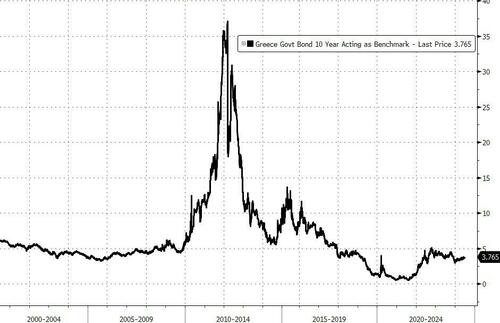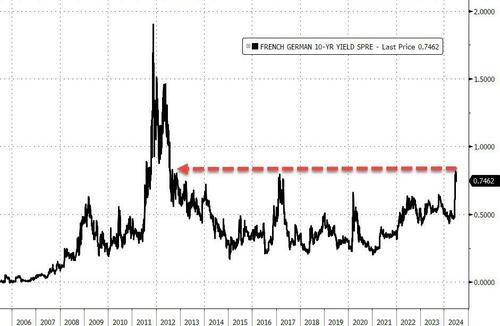Is France The Next Greece?
French markets have found some relief after the first round of its latest election, with stocks recovering somewhat and bond yields falling after reaching a 12-year high.
But no matter which side wins in France, the market is afraid that an increase in unsustainable spending could be the common denominator.
Greece’s sovereign debt crisis after the global 2008 implosion was characterized by an excessively high debt-to-GDP ratio, budget deficits, low growth, and an over-reliance on revenues from the tourism industry. Now, whispers abound in the Eurozone that in France, a similar crisis could be on the horizon.
With its entry into the Eurozone, Greece’s central bank lost much of its ability to kick the can down the road by printing money.
Long and short-term bond yields skyrocketed as the value of Greek debt plunged and bond investors fled to greener pastures. Greece’s 2015 default to the IMF totaled €1.6 billion.
Source: Bloomberg
France’s debt-to-GDP skyrocketed during COVID-19, and after inching downwards, it’s now trending back up and is expected to exceed COVID levels within a few years.
The French economy is unsure of how to react to the policy promises of the left or the right, so whispers of a potential debt crisis have far from stopped just because volatile French markets are experiencing a momentary breath of relief.
Eyes are on the yield spread between France and Germany.
Source: Bloomberg
Yields for “safe haven” German bonds have become the Eurozone benchmark, so the difference between German yields and those of other countries has become an indicator of the relative risk tolerance for investors in European government debt.
Both France and Belgium were once considered low-risk “core” nations among European economies, but that narrative is now changing as the problem of overspending is recognized across what were once regarded as economically stable countries.
Meanwhile, the US has many of the same problems — raging deficits, low growth, rising debt-to-GDP ratio, and high inflation. The US also has more tricks to kick the can down the road, but few options for truly fixing the problem.
HOW BAD THE US DEBT CRISIS HAS BECOME?
— Global Markets Investor (@GlobalMktObserv) June 26, 2024
US federal debt hit $34.8 trillion for the 1st time in history
In last 4 years, it has skyrocketed by $11 trillion, an equivalent of 40% US GDP.
By comparison, reaching the first $11 trillion it took 220 years.
How does it matter?🧵1/11. pic.twitter.com/TnSUYPvCpd
In 2010, the IMF defined an “unsustainable” debt-to-GDP ratio of an advanced economy to be around 180%. Officially, the current US debt-to-GDP ratio is “only” about 125%. But along with the Fed itself, Global lenders like the IMF are beginning to express concern about out-of-control budget deficits in major economies.
GDP alone doesn’t tell the story. A large part of the US GDP total is based on housing and the over-leveraged real estate market, an economic paper tiger that’s utterly dependent on low interest rates and central bank money printing. With real estate taking a range of 12 to 18% or more of the GDP pie depending on who you ask, the picture isn’t so reassuring. In Greece, the tourism industry was too dominant to handle an economic shock. In the US, it’s real estate.
There’s also the inconvenient truth that high inflation can make nominal GDP appear higher since the “market value” of the economy’s goods is higher on paper. When things cost more it can pump the GDP numbers, even though market value alone has nothing to do with whether an economy is healthy or unhealthy. Of course, Keynesians insist that this can equate to “real” growth, and economists continue debating if high GDP fuels high inflation, or the other way around.
Politicians love spending other people’s money because it makes them look good in the short term — and all that matters is winning that next election. But whether it’s Greece, France, Japan, or the US, there’s only so much debt a country can take on before entering a black hole. And there’s only so long that central banks can postpone the inevitable.




